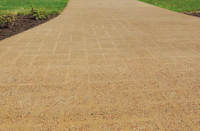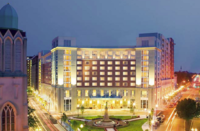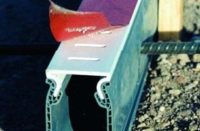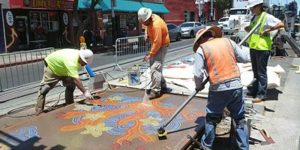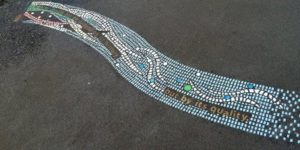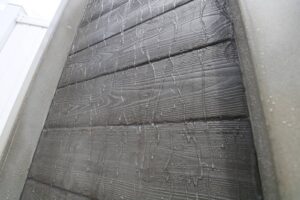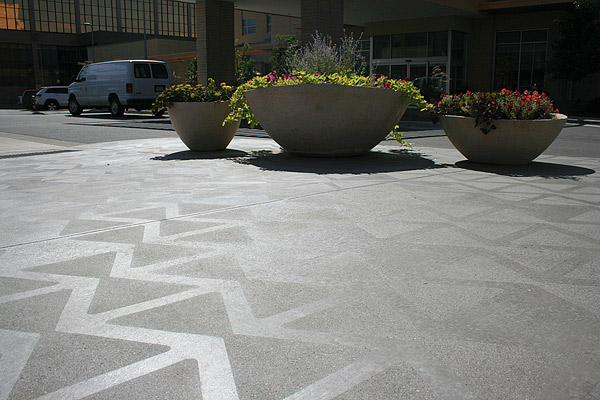
Some of the concrete design trends in Colorado differ from those in other parts of the country. In Colorado, we see a strong push for higher quality in even the most standard concrete. Even though we specialize in decorative concrete, some of our larger contracts this year include a good portion of standard uncolored broom-finished concrete because the owner or general contractor recognizes the value of having even the most basic concrete done correctly the first time. In addition to standard concrete sidewalks, driveways, curbs and gutters, our scope often includes forming unique stair or wall details, which can be challenging.
The popularity of Colorado Hardscapes’ Sandscape finish continues in Colorado. We see landscape architects and owners drawn to the versatility of this finish and it remains prevalent in many designs.
Stamped concrete, however, continues to fade in popularity. Because stamped concrete simulates another material, such as stone, many designers opt to use natural stone. However, designers continue to be drawn to natural concrete finishes, such as Sandscape or exposed aggregates, because they’re not trying to simulate another material.
Designs integrating lineal patterns and basic colors and finishes remain popular. A minor tweak in color or texture is prevalent in many designs. Subtle shifts in color and texture appeal to designers and owners in Colorado. We see this in either alternating bands with different depths of etching or sandblasting along with template sandblasting for subtle pavement enhancements.

Because of our state’s extreme temperatures and freeze-thaw climate, we see popularity in snowmelt systems. We team up with mechanical contractors to install radiant heat systems integral to our concrete paving. Hydronic systems are more popular than the electric systems.
We have to continue to educate architects about the design possibilities and limitations of interior concrete floors. Many still think of interior concrete floors as the traditional stained, sealed and waxed floors. They neither understand those limitations, nor the many other topping and polishing possibilities. They are getting better, but it’s an ongoing educational process.

As the design industry in Colorado becomes more educated about the realities and design potential of interior concrete, the possibilities seem to grow, especially for polished concrete. Some local architects understand concrete cracks and have learned the advantages of having the same concrete contractor place and polish concrete floors. When designed early enough, concrete mixes and aggregates are adjusted to meet the design intent. Through education and discussions, we see specifications requesting polishing to expose larger aggregates due to the design appeal along with the more consistent nature.
The artistic side of concrete design is reemerging along with the country’s economic recovery. Anything highly decorative or unique disappeared with the recession, but now that the economy has loosened up a bit, we see more of a demand for unique applications of concrete. These range from LithoMosaic art pieces that involve mosaics integrated into monolithic pours without hand seeding individual pieces to realistic-looking artificial rocks and trees. We also are seeing a reemergence of high-end water features.

Has decorative concrete made a complete recovery in Colorado? No, I don’t believe it has. Many projects are coming back to life that have been resting for years, and with them come some older trends or simpler designs from budget-minded development. But, as new designs are being created and projects have new life, I predict we will see a new push for decorative concrete that will expand and challenge the decorative concrete market here in Colorado and, I hope, across the nation.
Trends in the Rest of the Country
In comparison to Colorado’s market, I reached out to some of our industry friends to see what trends they observe in their markets.
Kansas City, Missouri:
“Exposed aggregate finishes (e.g., revealed and Sandscape) continue to be the predominant exterior finish for architectural concrete. From an interior perspective, the polished concrete market continues to grow, as well as the use of polishable overlays (e.g., Modena and Deco-Pour) as an alternative to terrazzo flooring.”
— Dan Kroesen, vice president, Musselman & Hall Contractors LLC
Phoenix, Arizona:
“In Phoenix, the architects are using a lot of finishes that work with contemporary buildings. So sand and acid-wash finishes are popular with clean saw-cut lines. Architects are always looking for something unique and innovative, just like we are. We currently have some projects with Lithocrete sedimentary walls, which is something new to the Arizona market, and another project with an elaborate template sandblast pattern that resembles leather with a tooled Western design that will be used at The Scottsdale Museum of the West in Scottsdale. Along with these finishes we still use Lithocrete, exposed aggregate and Bomanite.
— Mike Riggs, manager, Progressive Hardscapes
Charlotte, North Carolina:
“The main trends in the last several years have been to install alternative finishes like exposed aggregate or colored concrete finishes using some of the newer surface deactivation chemistry. I see the use of color moving away from the reds and dark grays toward tans and browns.”
— John Fletcher, president, Carolina Bomanite Corp.
San Diego, California:
“I continue to see a trend out West toward refined, highly detailed and smarter looking concrete surfaces. We are seeing renderings that depict decorative concrete surfaces that look cleaner and are represented with color, exposed aggregates and saw-cuts for a well-designed effect, whether it is a seeded aggregate or exposed aggregate concrete finish, including just exposing the fine sands on the surface of the concrete. I also see architects and owners, as well as us as a concrete contractor, trending toward concrete finishes that are easier and friendlier to maintain. By designing and selling these types of decorative concrete finishes, we can still install projects that look beautiful and are functional and practical as well!”
— Byron A. Klemaske, executive vice president, T.B. Penick & Sons Inc.
